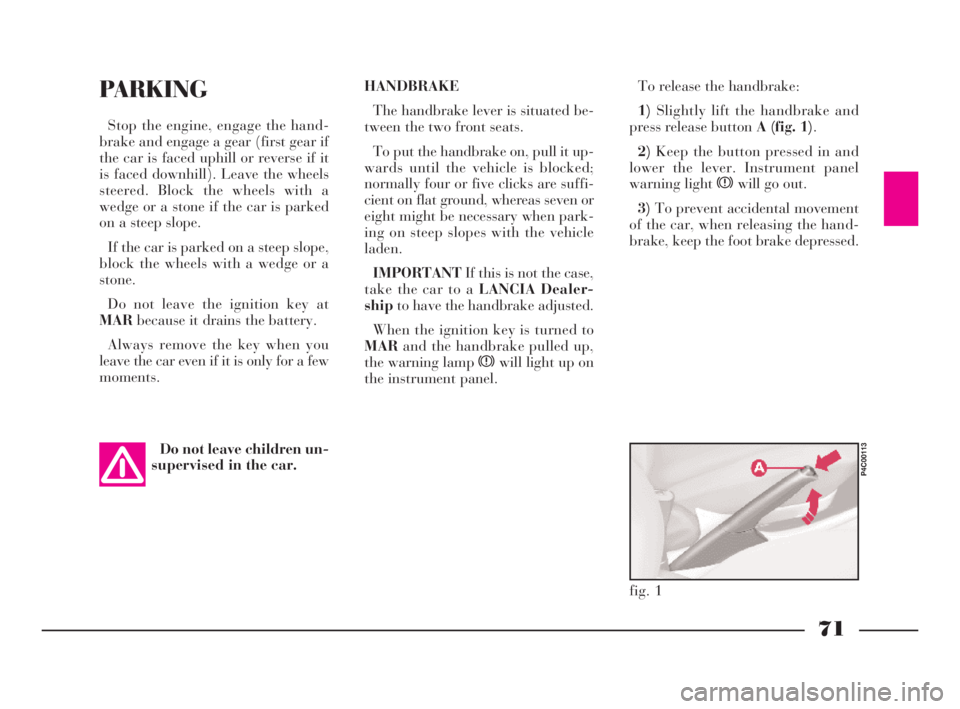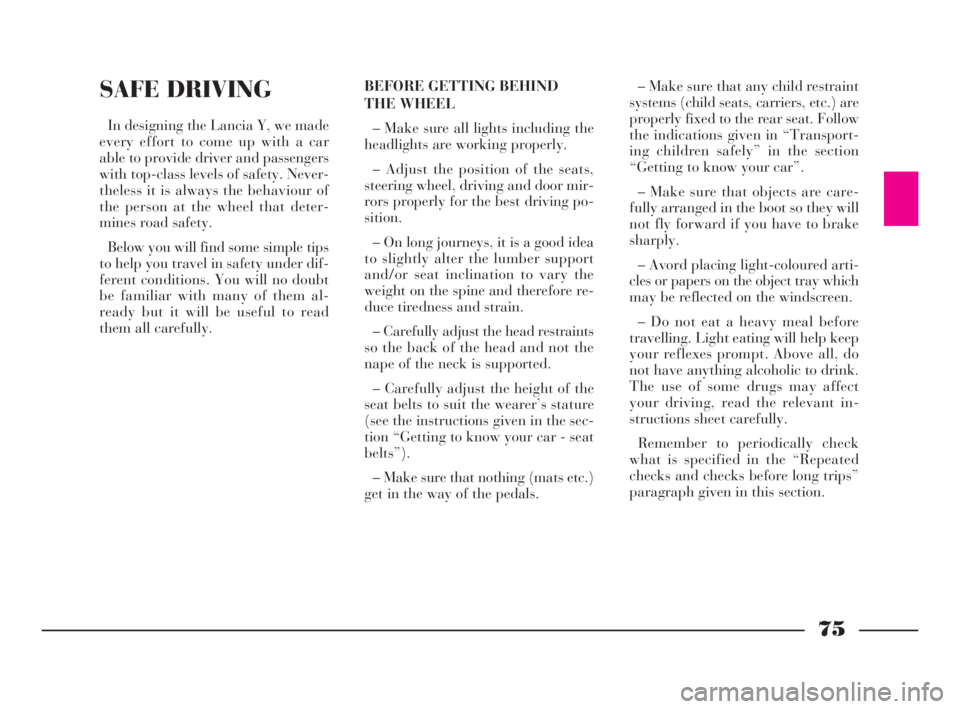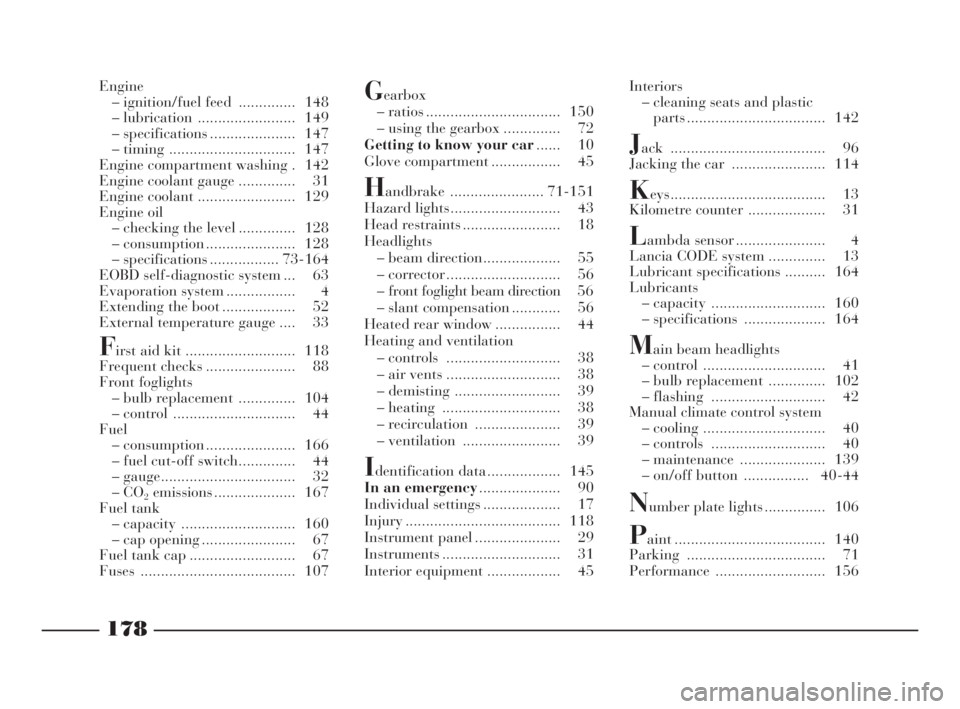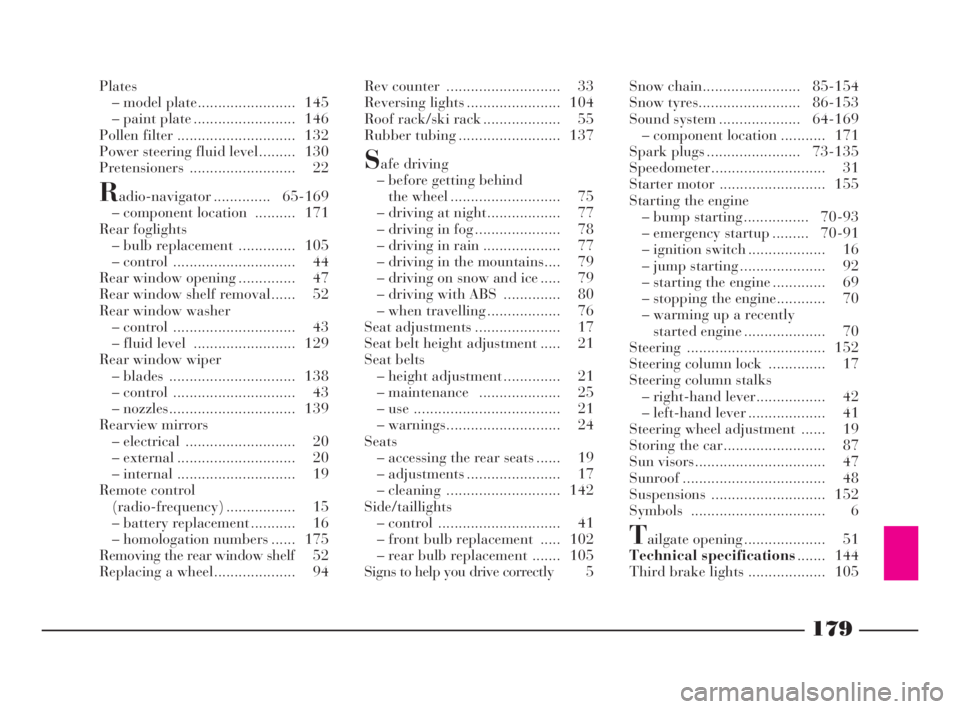seats Lancia Ypsilon 2002 Owner handbook (in English)
[x] Cancel search | Manufacturer: LANCIA, Model Year: 2002, Model line: Ypsilon, Model: Lancia Ypsilon 2002Pages: 191, PDF Size: 2.45 MB
Page 74 of 191

71
G
HANDBRAKE
The handbrake lever is situated be-
tween the two front seats.
To put the handbrake on, pull it up-
wards until the vehicle is blocked;
normally four or five clicks are suffi-
cient on flat ground, whereas seven or
eight might be necessary when park-
ing on steep slopes with the vehicle
laden.
IMPORTANTIf this is not the case,
take the car to a LANCIA Dealer-
shipto have the handbrake adjusted.
When the ignition key is turned to
MARand the handbrake pulled up,
the warning lamp xwill light up on
the instrument panel.To release the handbrake:
1)Slightly lift the handbrake and
press release button A (fig. 1).
2)Keep the button pressed in and
lower the lever. Instrument panel
warning light xwill go out.
3)To prevent accidental movement
of the car, when releasing the hand-
brake, keep the foot brake depressed.PARKING
Stop the engine, engage the hand-
brake and engage a gear (first gear if
the car is faced uphill or reverse if it
is faced downhill). Leave the wheels
steered. Block the wheels with a
wedge or a stone if the car is parked
on a steep slope.
If the car is parked on a steep slope,
block the wheels with a wedge or a
stone.
Do not leave the ignition key at
MARbecause it drains the battery.
Always remove the key when you
leave the car even if it is only for a few
moments.
Do not leave children un-
supervised in the car.
fig. 1
P4C00113
4C068-089 ING 11-03-2008 11:59 Pagina 71
Page 78 of 191

75
G
SAFE DRIVING
In designing the Lancia Y, we made
every effort to come up with a car
able to provide driver and passengers
with top-class levels of safety. Never-
theless it is always the behaviour of
the person at the wheel that deter-
mines road safety.
Below you will find some simple tips
to help you travel in safety under dif-
ferent conditions. You will no doubt
be familiar with many of them al-
ready but it will be useful to read
them all carefully.BEFORE GETTING BEHIND
THE WHEEL
– Make sure all lights including the
headlights are working properly.
– Adjust the position of the seats,
steering wheel, driving and door mir-
rors properly for the best driving po-
sition.
– On long journeys, it is a good idea
to slightly alter the lumber support
and/or seat inclination to vary the
weight on the spine and therefore re-
duce tiredness and strain.
– Carefully adjust the head restraints
so the back of the head and not the
nape of the neck is supported.
– Carefully adjust the height of the
seat belts to suit the wearer’s stature
(see the instructions given in the sec-
tion “Getting to know your car - seat
belts”).
– Make sure that nothing (mats etc.)
get in the way of the pedals.– Make sure that any child restraint
systems (child seats, carriers, etc.) are
properly fixed to the rear seat. Follow
the indications given in “Transport-
ing children safely” in the section
“Getting to know your car”.
– Make sure that objects are care-
fully arranged in the boot so they will
not fly forward if you have to brake
sharply.
– Avord placing light-coloured arti-
cles or papers on the object tray which
may be reflected on the windscreen.
– Do not eat a heavy meal before
travelling. Light eating will help keep
your reflexes prompt. Above all, do
not have anything alcoholic to drink.
The use of some drugs may affect
your driving, read the relevant in-
structions sheet carefully.
Remember to periodically check
what is specified in the “Repeated
checks and checks before long trips”
paragraph given in this section.
4C068-089 ING 11-03-2008 11:59 Pagina 75
Page 79 of 191

76
G
Consider the space re-
quired by extra mats: even
a small problem to the
braking system may indicate addi-
tional brake pedal stroke is re-
quired with respect to normal.
Water, ice and salt sprin-
kled on the road deposit
on the brake disc and re-
duce effectiveness the first time
you brake.
WHEN TRAVELLING
– The first rule of safe driving is pru-
dence.
– Prudence also means putting your-
self into a position where you can pre-
dict wrong or imprudent behaviour
from other drivers.
– Stick closely to the rules of the
road in the particular country where
the car is being driven and, above all,
do not exceed speed limits.
– Ensure that, besides yourself, all
the other passengers in the car have
their seat belts fastened, that children
are sitting in the appropriate child
seats and any animals are in special
compartments.
– You should be physically fit and
mentally alert before setting out on
long journeys.Driving when you are not
mentally alert, drunk, un-
der the influence of drugs
or certain medicines is dangerous
both for you and other road users.
Always fasten both front
and back seat belts in-
cluding child seat seat belt
if fitted. Travelling with the seat
belts unfastened increases the risk
of injury or death if you are in a
collision.
Pay attention when in-
stalling additional spoil-
ers, alloy wheel rims and
caps that are not standard. They
could reduce the brake ventilation
and as a consequence, the braking
efficiency if you brake suddenly
and repeatedly, or when driving
downhill.Do not drive with objects
on the floor in front of the
driver’s seat. Objects
could get stuck under the pedals
making accelerating and braking
impossible.
4C068-089 ING 11-03-2008 11:59 Pagina 76
Page 145 of 191

Detergents pollute water.
The car must therefore be
washed in an area
equipped for the collection and
purification of the liquids used
while washing.
IMPORTANTThe car should be
washed while the engine is cold and
with the ignition key at STOP. After
washing the car, make sure that the
various protections (e.g. rubber boots
and various guards) have not been re-
moved or damaged.
142
G
Windows
Use specific window cleaners to
clean the windows. Use very clean
cloths to avoid scratching the glass or
damaging its transparency.
IMPORTANTTo prevent damage
to the electric heater elements, wipe
the inside of the heated rear window
gently in the same direction as the el-
ements.
Engine compartment
At the end of each winter season,
carefully clean the engine compart-
ment. Be careful not to direct the jet
of water on the electronic control
units. Have this done at a garage.INTERIORS
From time to time check that water
has not collected under the mats
(from dripping shoes, umbrellas etc.)
which could cause the steel to rust.
CLEANING THE SEATS
AND FABRIC UPHOLSTERY
– Remove the dust with a soft brush
or a vacuum cleaner.
– Rub the seats with a sponge moist-
ened in a solution of water and neu-
tral detergent.
4C120-143 ING 11-03-2008 12:01 Pagina 142
Page 146 of 191

143
G
PLASTIC PARTS INSIDE
THE CAR
Use special products designed not to
alter the appearance of the compo-
nents.
IMPORTANTDo not use alcohol or
petrol for cleaning the glass of the in-
strument panel.CLEANING LEATHER SEATS
AND PARTS
– Remove the dry dirt with a buck-
skin or very slightly moist cloth with-
out exerting too much pressure.
– Remove liquid or grease stains
with a dry absorbent cloth without
rubbing. Then wipe with a buckskin
or soft cloth moistened with water and
neutral soap.
If the stain does not come out, use a
special cleaning compound being par-
ticularly careful to follow the instruc-
tions for use.
IMPORTANTNever use alcohol or
alcohol-base products.Do not keep aerosol cans
in the car. There is the risk
they might explode. Aerosol
cans must never be exposed to a
temperature above 50°C; when the
weather starts to get hot the tem-
perature inside the car might go
well beyond that figure.
Never use flammable
products (petroleum ether
or petrol) to clean the in-
side of the car. Electrostatic
charges generated by rubbing
while cleaning could cause fires.
4C120-143 ING 11-03-2008 12:01 Pagina 143
Page 161 of 191

158
G
DIMENSIONS
P4C00387fig. 5 Boot volume (VDA standard)
With seats in normal
position:............................ 215 dm
3
With seats folded down and load
flush with the roof: ............ 910 dm3
The height and the tracks refer to
the car when empty.
4C144-167 ING 11-03-2008 12:02 Pagina 158
Page 171 of 191

ACCESSORY INSTALLATION
Genuine Lancia accessories have been designed
with the Lancia Y specifically in mind and have
been selected and tested on the car. They are easy
to use, reliable and practical: qualities that lead
to enhanced comfort and safety under all driving
conditions.
For child safety, the child seats in the Lineac-
cessori Lancia line meet the strictest current Eu-
ropean standards.
You can find the Lancia accessories described in
a catalogue available from Lancia Dealerships.
Just ask the staff to give you all the details.
The following pages show diagrams and give in-
structions for correctly fitting a number of acces-
sories. Installation must always be entrusted to the
experts. Lancia has specially trained its Dealer-
ship staff for work on the Lancia Y.SOUND SYSTEM/RADIO NAVIGATION
SYSTEM......................................................... 169
TOW HITCH .................................................. 172
RF REMOTE CONTROL:
MINISTERIAL HOMOLOGATION .................. 175
168
G
4C168-176 ING 11-03-2008 12:03 Pagina 168
Page 181 of 191

178
fdG
Interiors
– cleaning seats and plastic
parts .................................. 142
Jack ...................................... 96
Jacking the car ....................... 114
Keys...................................... 13
Kilometre counter ................... 31
Lambda sensor ...................... 4
Lancia CODE system .............. 13
Lubricant specifications .......... 164
Lubricants
– capacity ............................ 160
– specifications .................... 164
Main beam headlights
– control .............................. 41
– bulb replacement .............. 102
– flashing ............................ 42
Manual climate control system
– cooling .............................. 40
– controls ............................ 40
– maintenance ..................... 139
– on/off button ................ 40-44
Number plate lights ............... 106
Paint ..................................... 140
Parking .................................. 71
Performance ........................... 156 Engine
– ignition/fuel feed .............. 148
– lubrication ........................ 149
– specifications ..................... 147
– timing ............................... 147
Engine compartment washing . 142
Engine coolant gauge .............. 31
Engine coolant ........................ 129
Engine oil
– checking the level .............. 128
– consumption ...................... 128
– specifications ................. 73-164
EOBD self-diagnostic system ... 63
Evaporation system ................. 4
Extending the boot .................. 52
External temperature gauge .... 33
First aid kit ........................... 118
Frequent checks ...................... 88
Front foglights
– bulb replacement .............. 104
– control .............................. 44
Fuel
– consumption ...................... 166
– fuel cut-off switch.............. 44
– gauge................................. 32
–CO
2emissions .................... 167
Fuel tank
– capacity ............................ 160
– cap opening ....................... 67
Fuel tank cap .......................... 67
Fuses ...................................... 107
Gearbox
– ratios ................................. 150
– using the gearbox .............. 72
Getting to know your car...... 10
Glove compartment ................. 45
Handbrake ....................... 71-151
Hazard lights........................... 43
Head restraints ........................ 18
Headlights
– beam direction................... 55
– corrector ............................ 56
– front foglight beam direction 56
– slant compensation ............ 56
Heated rear window ................ 44
Heating and ventilation
– controls ............................ 38
– air vents ............................ 38
– demisting .......................... 39
– heating ............................. 38
– recirculation ..................... 39
– ventilation ........................ 39
Identification data .................. 145
In an emergency.................... 90
Individual settings ................... 17
Injury ...................................... 118
Instrument panel ..................... 29
Instruments ............................. 31
Interior equipment .................. 45
4C177-184 Indice ING 13-03-2008 13:31 Pagina 178
Page 182 of 191

179
fdG
Plates
– model plate........................ 145
– paint plate ......................... 146
Pollen filter ............................. 132
Power steering fluid level......... 130
Pretensioners .......................... 22
Radio-navigator .............. 65-169
– component location .......... 171
Rear foglights
– bulb replacement .............. 105
– control .............................. 44
Rear window opening .............. 47
Rear window shelf removal...... 52
Rear window washer
– control .............................. 43
– fluid level ......................... 129
Rear window wiper
– blades ............................... 138
– control .............................. 43
– nozzles............................... 139
Rearview mirrors
– electrical ........................... 20
– external ............................. 20
– internal ............................. 19
Remote control
(radio-frequency) ................. 15
– battery replacement ........... 16
– homologation numbers ...... 175
Removing the rear window shelf 52
Replacing a wheel.................... 94Rev counter ............................ 33
Reversing lights ....................... 104
Roof rack/ski rack ................... 55
Rubber tubing ......................... 137
Safe driving
– before getting behind
the wheel ........................... 75
– driving at night.................. 77
– driving in fog ..................... 78
– driving in rain ................... 77
– driving in the mountains.... 79
– driving on snow and ice ..... 79
– driving with ABS .............. 80
– when travelling .................. 76
Seat adjustments ..................... 17
Seat belt height adjustment ..... 21
Seat belts
– height adjustment .............. 21
– maintenance .................... 25
– use .................................... 21
– warnings............................ 24
Seats
– accessing the rear seats ...... 19
– adjustments ....................... 17
– cleaning ............................ 142
Side/taillights
– control .............................. 41
– front bulb replacement ..... 102
– rear bulb replacement ....... 105
Signs to help you drive correctly 5Snow chain........................ 85-154
Snow tyres......................... 86-153
Sound system .................... 64-169
– component location ........... 171
Spark plugs ....................... 73-135
Speedometer............................ 31
Starter motor .......................... 155
Starting the engine
– bump starting ................ 70-93
– emergency startup ......... 70-91
– ignition switch ................... 16
– jump starting ..................... 92
– starting the engine ............. 69
– stopping the engine............ 70
– warming up a recently
started engine .................... 70
Steering .................................. 152
Steering column lock .............. 17
Steering column stalks
– right-hand lever................. 42
– left-hand lever ................... 41
Steering wheel adjustment ...... 19
Storing the car......................... 87
Sun visors................................ 47
Sunroof ................................... 48
Suspensions ............................ 152
Symbols ................................. 6
Tailgate opening .................... 51
Technical specifications....... 144
Third brake lights ................... 105
4C177-184 Indice ING 13-03-2008 13:31 Pagina 179